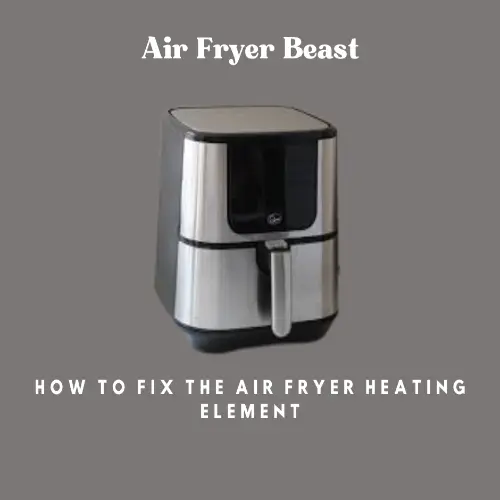Originally posted on 7 September 2023 @ 15:01
How to fix the air fryer heating element:
Is your air fryer not crisping up those fries or wings like it used to? An air fryer that’s not heating may have an issue with its heating element. Read on to learn how to check a faulty heating element in an air fryer and determine if replacement is needed.
An air fryer is a popular kitchen appliance that uses superheated air and a touch of oil to “fry” foods with less fat than deep frying. This convection cooking method relies on the air fryer’s heating element to quickly circulate hot air around the food. When the heating mechanism fails, the air fryer is rendered useless.
This comprehensive guide will explain how an air fryer heating element works, why it may stop working correctly, and how to test and potentially replace this crucial part of your air fryer. With some troubleshooting tips, you may get your air fryer heating up again or determine that replacement is the best solution for a broken heating element.
How Does the Heating Element in an Air Fryer Work?
The heating element in an air fryer is a coiled metal tube that heats up rapidly when an electrical current passes through it. It is designed to heat up to 400°F in most air fryer models.
Positioned at the top of the cooking chamber, this heating coil emits radiant heat downwards, and a fan circulates this hot air around the food at high speeds. This rapid flow of scorching air gives fried foods a crisp exterior like deep frying.
Power cord issues, failed safety features, or a damaged heating element coil can all prevent your air fryer from heating up properly. Troubleshooting the heating element is one of the first steps in diagnosing an air fryer that is not getting hot.
Why Is the Heating Element in My Air Fryer Not Working?
There are several reasons why the heating element in your air fryer may stop functioning correctly:
Power Problems
- Faulty electrical outlet – Try plugging into another outlet to ensure power flows correctly.
- Tripped breaker – Check if the circuit breaker controlling the outlet has tripped and needs to be reset.
- Damaged power cord – Inspect the power cord for damage or exposed wires interrupting the power supply.
Safety Feature Malfunction
- Some air fryers have auto shut-off features that turn the fryer off if it overheats. A faulty sensor could activate this prematurely.
- Thermostat issues – The thermostat controls the heating element. If it is broken, it won’t signal the element to heat.
Heating Element Failure
- Burnt out – The heating coil can burn out after prolonged use and no longer heat up when electricity flows through it.
- Broken – Over time, the coiled metal tube can develop cracks or breaks that keep it from working.
- Loose wiring – Wires connecting the heating element to power can come loose over time.
- Food buildup – Excess grease, oil, and food debris around the heating element can impede airflow and heat production.
How to Check the Heating Element in an Air Fryer
If your air fryer is not heating up, the first step is running through some troubleshooting checks on the heating element:
- Visual Inspection – Open the air fryer cooking basket and examine the heating element for any visible damage, cracks, breaks, bulges, or burnt spots.
- Power Supply – Ensure the air fryer is securely plugged into a working electrical outlet. Try resetting a tripped breaker or use a different outlet.
- Power Cord – Inspect the power cord thoroughly for damage. A faulty cable can prevent power from reaching the heating element.
- Dirt Buildup – Remove any excess dirt, oil, or debris around the heating element that could impede airflow.
- Continuity Check – Use a multimeter to check for continuity in the coil. Breaks in continuity indicate damage.
- Resistance Test – Check if the heating element reaches the high resistance required to produce heat using a multimeter.
If issues are found through visual inspection or electrical testing, replacement of the heating element may be required. Next, we’ll look at how to remove and replace a defective heating element in an air fryer.
Removing and Replacing a Faulty Heating Element
Before replacing the heating element, always unplug your air fryer and allow the aspect and internal components to cool completely to avoid burns.
You’ll need a Phillips head or Torx screwdriver to access the internal chamber and heating element. The heating element is located at the top of the cooking chamber and is usually held in place by several screws. The number of screws and mounting bracket styles varies by air fryer model.
Follow these general steps:
- Unplug the air fryer and remove the food basket/trays, grease filter, and other removable parts from the cooking chamber.
- Carefully flip the air fryer over to access the bottom panel held in place by screws. Remove the bottom panel.
- Detach any wiring connectors leading to the heating element, noting where they attach for reassembly.
- Unscrew and remove any mounting brackets around the heating element. Caution: The heating element coil may be brittle.
- Once unmounted, gently lift out the old heating element, careful not to break the fragile coil.
- Before installing the new replacement heating element, thoroughly clean the air fryer chamber’s interior.
- Carefully insert the new heating element into position, remount it with brackets and screws. Reattach any wiring connectors leading to the component.
- Replace the bottom panel and any other parts removed earlier. Plug in the air fryer and test the heating function.
Purchasing the correct replacement part number for your air fryer make and model is crucial when fixing a broken heating element. Consult your owner’s manual or manufacturer guidelines to ensure you get the proper heating element replacement part.
Why Does My Air Fryer Have a Heating Element Problem?
Air fryer heating elements can fail or malfunction for several reasons:
- Normal wear and tear – With regular use, the heating coil degrades and eventually ceases to heat. Life expectancy is 2-3 years.
- Power surges – Spikes in electrical current can damage the heating element. Using a surge protector can help.
- Improper use – Overfilling the basket or improper cooking techniques stress the heating element.
- Lack of maintenance – Not cleaning the air fryer and removing built-up debris around the heating element can prevent it from failing prematurely.
- Manufacturing defects – In some cases, the heating element may be defective right out of the box due to a manufacturing flaw.
Replacing a worn-out or defective heating element is often more cost-effective than purchasing an entirely new air fryer. With proper use and care, your new heating element could last the lifetime of your appliance.
FAQs
How do I replace the heating element in my air fryer?
To replace the heating element in your air fryer, you must follow the specific instructions provided by the manufacturer. Generally, you will need to disassemble the air fryer, locate the heating element, disconnect the electrical connections, and then install the new heating element in its place. It is recommended to consult the user manual or contact customer support for detailed guidance.
What should I do if the heating element in my air fryer is not working?
If the heating element in your air fryer is not working, there are a few steps you can take to troubleshoot the issue. First, ensure the air fryer is correctly connected to a power outlet. Check for any visible signs of damage or malfunction on the heating element. Clean the heating element to remove any residue or buildup affecting its performance. If the issue persists, you may need to replace the heating element.
How do I clean the heating element of my air fryer?
Cleaning the heating element of your air fryer is an important maintenance step. To clean the heating element:
- Ensure the air fryer is unplugged and completely cooled down.
- Gently wipe the surface of the heating element with a soft, damp cloth or sponge.
- Do not use abrasive cleaners or scrub the heating element vigorously, which may cause damage.
- Dry the heating element thoroughly before reconnecting and using the air fryer.
Can I remove the heating element from my air fryer for cleaning?
In most air fryer models, the heating element is not designed to be removed for cleaning. It is recommended to clean the heating element in place, following the manufacturer’s instructions for cleaning and maintenance.
Disconnect the air fryer from the power source and thoroughly cool it before cleaning the heating element.
When should the heating element of my air fryer be replaced?
The heating element of your air fryer may need to be replaced if it is no longer functioning correctly despite troubleshooting and cleaning. Signs that the heating element may need replacement include consistent failure to heat up, uneven heating, or visible physical damage.
It is best to consult the manufacturer or contact customer support for guidance if you need more clarification.
What can cause the heating element in my air fryer to malfunction?
Several factors can cause the heating element in your air fryer to malfunction. One common cause is a buildup of residue or grease on the heating element, hindering its heat distribution. Another possibility is a damaged or faulty electrical connection.
Power fluctuations or a defective power outlet can also affect the performance of the heating element. It is essential to properly clean and maintain the air fryer to minimize the risk of heating element malfunction.
How do I check the heating element in my air fryer?
To check the heating element in your air fryer, you will need to inspect it visually. Make sure the air fryer is unplugged and cooled down. Look for signs of physical damage, such as discoloration, cracks, or loose connections.
If you notice any abnormalities, it may indicate a problem with the heating element that needs to be addressed.
What should I do if my air fryer is not heating up?
If your air fryer is not heating up, there are several steps you can take to troubleshoot the issue. First, check if the air fryer is securely plugged into a power outlet and that the outlet is functioning correctly. Ensure that the air fryer basket is appropriately positioned and that there are no obstructions to the air circulation.
Clean the heating element and remove any residue affecting its performance. If the problem persists, you may need to contact customer support or consider replacing the heating element.
How can I ensure the proper functioning of the heating element in my air fryer?
To ensure the proper functioning of the heating element in your air fryer, it is essential to follow appropriate cleaning and maintenance practices. Regularly clean the heating element to remove any residue or buildup affecting its performance.
Check the air fryer for any visible signs of damage or wear and tear. Pay attention to the power outlet and ensure a stable power supply. Following the manufacturer’s guidelines for usage and maintenance will help maximize the lifespan and efficiency of the heating element.
Key Takeaways on Air Fryer Heating Elements
- The heating element is an electric coil that heats the air to 400°F for crispy “air-fried” cooking.
- Check for visible damage, power issues, or blockages if your air fryer is not heating correctly.
- Use multimeter testing to check for continuity or resistance problems signaling a defective element.
- Carefully detach the wiring and mounting brackets to remove the old heating element for replacement.
- Match heating element replacement parts to your specific model’s make and serial number.
- Reasons for heating element failure include wear and tear, power surges, misuse, lack of cleaning, and manufacturing defects.
Don’t toss an air fryer that’s not heating! With a few troubleshooting tips, you can likely diagnose and fix a broken heating element that is the culprit behind your air fryer’s failure to heat up. Just be sure to address any heating element issues promptly and safely. You can get your air fryer back up and running hot with a simple replacement part.

I’m Ian Welkins, a seasoned professional in the kitchen industry. My passion now drives me to provide invaluable insights into the world of top-notch kitchen products. With years of hands-on experience, I’m your go-to source for culinary excellence.











